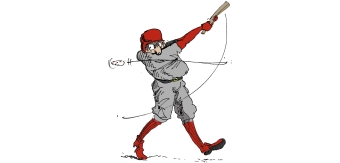For this year’s UK General Election, Channel 4 sought to create a campaign that would not only resonate with its audience but encourage people to get out and vote. Whether it worked or not is debatable, given the generally poor voter turnout last Thursday, but the idea here is still genuinely inventive.
The resulting campaign, "Be Lazy, Just Vote," cleverly intertwined Channel 4's distinct personality with a crucial civic message. This interview with the team behind the idea delves into the creative process, challenges, and collaborative efforts behind the campaign, offering insights into how the brand maintained its innovative edge in a crowded media landscape.
What was the brief?
Channel 4 has a rich history of generating awareness of important social issues in creative and disruptive ways. Recently we’ve paid homage to 90s rave culture in support of our docudrama "Partygate," and our “carbon skidmarks” campaign poked at the narrative around climate change. The 2024 election presented a key opportunity for us to showcase our remit in a distinctive way during a crucial moment for the country. More than anything, we wanted to create impact.
How did the initial pitch/brainstorming phase go?
What makes a project like this a more complex challenge is that as a brand piece rather than a campaign attached to a specific product or programme, you have a much broader creative and media playing field. Added to that, there is a vast amount of data and research in this area.
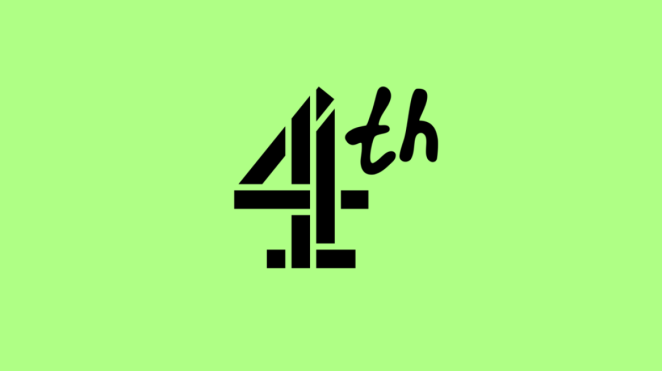
So being very focused on which insights will lead your thinking is vital. In addition, you know other brands are probably working on a similar brief simultaneously, so our brand’s tone of voice needed to shine through. We had a couple of initial sessions with a very loose brief and some territories to explore.
With research, planning, marketing, and creative teams working together at this stage, we felt much clearer on the challenges, potential pitfalls, and opportunities ahead. That really helped us get to good creative quickly, which in the (unforeseen) circumstances was very bloody helpful.
What was the process behind ideating the concept?
We had an initial formal creative briefing, then the next day followed up with a more casual discussion with the creative teams of the project. We discussed media opportunities, potential creative ways in, and looked at any stimulus that came to mind.
At the time of briefing, the election had not yet been called; however, almost immediately, a rain-soaked Rishi Sunak dropped the major surprise. Blind panic very quickly subsided (honest), and after a regroup and a shift of focus from driving voter registration to voting itself, we felt we had a clear objective. The initial groundwork of identifying strong territories helped get us to good routes quickly.
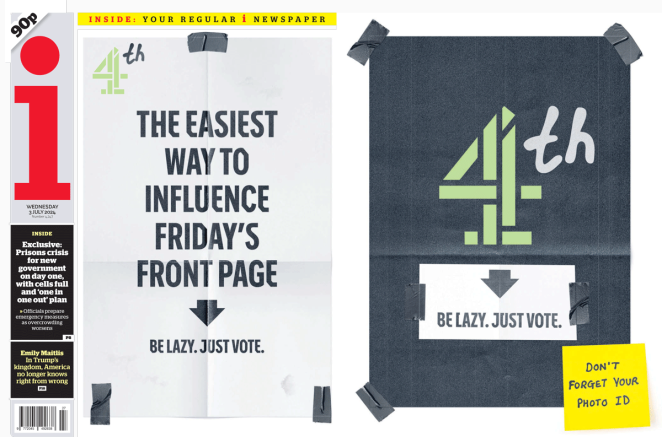
Although we had to share work that was less developed than we would like, we had three or four strong creative concepts that we felt confident about crafting into a cohesive campaign that had enough clarity that even wider stakeholders could buy into them early on.
What was the production process like?
Quick!
What was the biggest challenge during production? How did you overcome it?
Just the huge number of deliverables needed in such a short period of time. In total, we produced over 100 individual assets across linear, streaming, social, audio, OOH, print, and PR. We therefore made as much as possible either in-house or with trusted partners - favours and really good working relationships were key.
What kit/tools/software were used to create the project?
Nothing out of the ordinary for this one (mainly Adobe Creative Suite). And some good old-fashioned paper and paint. And of course, blood, sweat, and tears!
What is one funny or notable thing that happened during production?
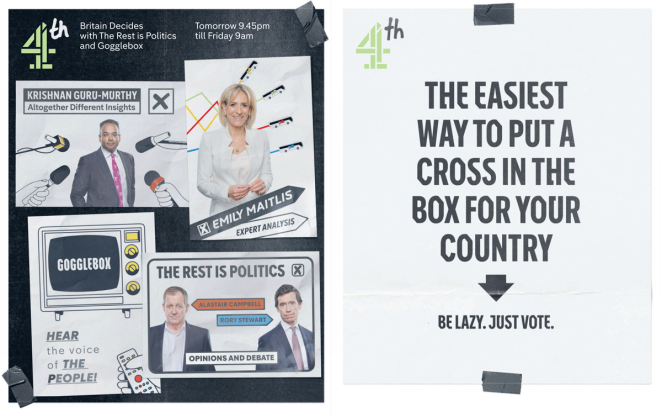
Krishnan Guru Murthy stood there holding an oversized duster that was brought out from the Channel 4 cleaning cupboard.
What’s the main message of this project and why does it matter?
Go Vote. Cynicism, apathy, and dissatisfaction feel like they are at an all-time high, but by participating in an election, you are at least showing you care enough to engage, even if you feel British political parties and the system leave a lot to be desired.
How long did it take from inception to delivery?
About 1 month.
Can you describe the creative spark or inspiration behind the initial concept? Was there a specific moment or insight that ignited the idea?
The world is a lot right now; people want to make a difference, but it feels like you need to do something big to make it matter. But with a polling station, on average, closer than your local pub, voting is truly the laziest form of meaningful activism. We did not want to be preachy, and it’s not very common in today’s society to tell people to embrace laziness, which felt quite refreshing.
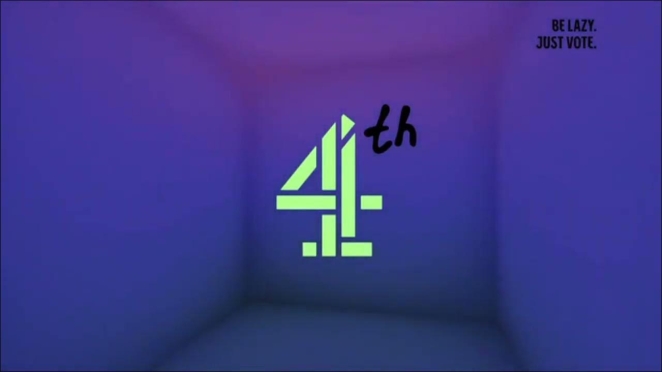
Another piece of good fortune that we made the most of: When the date of the election was announced as July 4th, one of the creative teams made the obvious leap to add ‘th’ to our existing brand - one of those obvious things that seems so obvious once someone clever has thought of it.
How did you ensure that the concept aligned with the brand's values, goals, and target audience?
Tone of voice is vital for us. ‘4-ness’ and the idea of being ‘Altogether Different’ has to be central to all the brand work we do. We want people to feel heard, included, and for differences to be respected and celebrated. So, when it comes to questions around politics, it is particularly challenging to find the right line.
We were desperate not to talk down to people, appear self-righteous, or dismissive. We knew we wanted to keep a sense of levity and a feeling that this was a gentle reminder to vote rather than us issuing some sort of edict or guilting people into doing the ‘right thing.’
Were there any alternative concepts or ideas considered during the ideation phase? If so, what led to the selection of the final concept?
We had a couple of other routes on the table, which had a great sense of mischief and fun, but we discounted them for a couple of reasons. Firstly, they were too focused on young voters, which in itself has the potential of being divisive, condescending, and giving off ‘dad at a disco’ vibes. Secondly, using our brand tone of voice as the ultimate filter for the creative, the routes we ended up with just made the most sense for Channel 4.
Can you discuss any collaborative or interdisciplinary aspects of the ideation process, such as working with other departments or external partners?
We ended up working with almost every department at Channel 4 to update as much as possible from 4 to 4th across all touchpoints within the brand. From continuity to broadcast ops and presentation to access services, we pulled off a mini rebrand in a matter of weeks, which usually takes a matter of years!

Outside of Channel 4, we collaborated with some of our most trusted partners, knowing we had limited time and budget. We worked with Picture Shop across all idents, Platform for our promo post-production, and Curious across photography and retouching.
What role did consumer research or market analysis play in shaping the concept and its execution?
Our brief was rooted in extensive research and insight. Eighteen months ago, Channel 4 released Beyond Gen Z, our report into the truth about British youth. Amongst many things, the research highlighted how young people feel about politics today and how many of them feel they can’t make a meaningful difference to society - even if they wanted to.
What surprised us was that the same was true for older generations too. "Be Lazy Just Vote" aims to remind everyone - but especially young people - that the biggest way to make a difference is also the easiest. We can all contribute meaningfully to our society, but we can also do that in a really lazy way.
Can you discuss any unique or unconventional production techniques or approaches used to bring the idea to life?
The only unconventional and unique part was how conventional it was. From a stunt using multiple brooms and mops stuck together and a banner stuck up with tape to adding a simple ‘th’ to our logo, there was no fancy CGI or big post budget. Just in-house talent and some trusted partners.
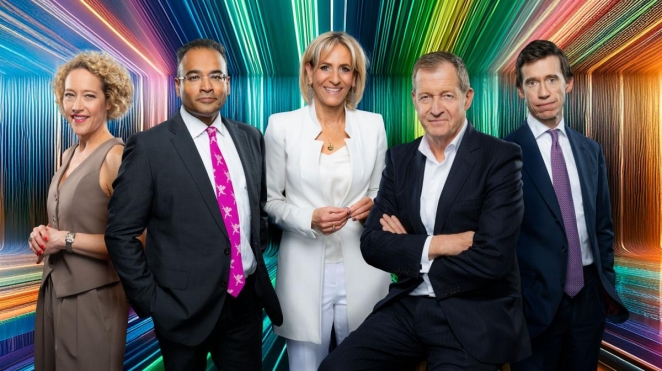
How did you ensure that the concept remained innovative and stood out in a crowded marketplace?
We hope that the sense of humour and lo-fi design aesthetic that runs through the campaign helped make it stand out amongst all the (often negative) noise and hyperbole around the election campaign. In addition, adding contextual lines into the campaign made it feel a bit more distinctive and relevant.
What do you hope it achieves for the brand?
We hope it continues the legacy of Channel 4 doing its public service broadcaster duties but doing them with a sense of fun, relatability, and entertainment.




